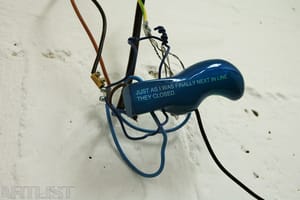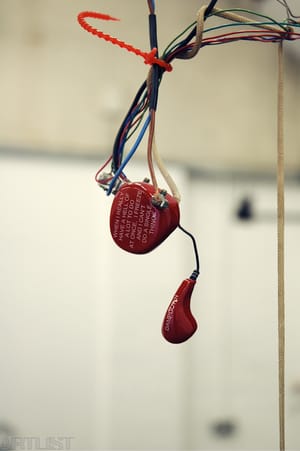- Author
-
Jiří Černický
- Year
- 2005
- Year to
- 2006
- Technique and size
mixed media
About work
The “Binds” are small objects that develop ideas of abstract sculpture. They are not, however, sculptures in the true sense of the word, but rather something reminiscent of them. It is not their ideal function to exist as independent objects. Their real meaning is connected to the context of which they are a part, or on which, in extreme cases, they parasite. It is therefore more a matter of components, segments, units, interlinks, bindings, complicators, decelerators …
In order for it to be possible to connect a “bind” to a context, it is equipped with amateur, but nonetheless expressive and functional devices (karabiners, clips, wires, cables, strings…). The object as a whole is intended to create a somewhat wild, chaotic, amateur and perhaps even overcomplicated impression – as if someone had attempted several times to make running repairs to the object under unsuitable conditions. Some of the “binds” therefore appear quite bungled.
These “binds” could be, for example, components of a specific thing (a refrigerator, bookcase, car, computer, toy, or some other work of art…), or of a specific space (electrical ciruit, heating system, or other network or system…). I believe there is also a possibility here to connect a “bind” with a person (e.g. with his belt, keyring, briefcase…).
The task of the “Bind” is to complicate the context of which it is a part, or at least to make it more complex. A further function is to alter the meaning of the context. For that reason, each object is equipped with a text – a so-called “binding declaration”, which describes a banal real-life event. The character of these statements is very ordinary and simple to the point of fatality, in order for the “binds” to acquire a social, human “nature”. This acts on the observer in such a manner as to allow him to identify with it, and it would not be inappropriate if it were to evoke in him a gentle sensation of fellow feeling or sympathy. These texts also capture situations that are “binds” or binding in life. They describe, for example, occurrences that prevent us from achieving a goal that we consider important. They sometimes outline a mini-story with an insidious or perplexing meaning. Very often they describe a problem that interrupts or delays us etc.
Just as the objects have an abstract basis, I also perceive the character of the texts as an abstraction of a kind, as they have a drab nature. There are simply too many such situations in our lives, to the point where they dissolve and lose clarity. They bother us just a little for a while and then we try to erase them from our minds, empty them, or in the best of cases, make fun of them. In any case, they are lost after a time and nothing is left of them.
What I see as important, however, is that, despite all their pettiness, they create one of the fundamental elements of our lives, with which it is best to reconcile ourselves and attach at least some small importance to.
One of the options for installing the “binds” in a space (e.g. in a gallery), is to connect them to a real or fictitious electrical system and to complicate it by opening it in a number of places, exposing cables, sockets etc. and attaching the “binds” to the system. It is well to act in such a complicated manner. I would derive inspiration for example from electrical circuits in the poor quarters of the “Third World”, which would, in their perfect amateurism, outdo the corridors of Prague public buildings.



